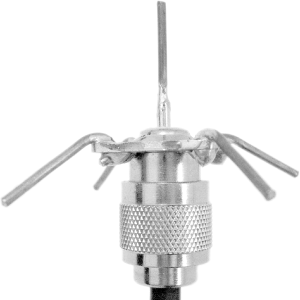Hack 71 Spider Omni
Hack 71 "Spider" Omni
Possibly the smallest and simplest omnidirectional antenna there is. This is one of the simplest and smallest antenna designs I've seen for 2.4 GHz. It isn't much larger than a standard N connector because that is exactly what it is made of. It has been dubbed the spider omni, since it looks a bit like a crazed spider crawling up your antenna feed (Figure 5-3). Technically, it is a ground plane antenna, but practically speaking, it acts like a vertically polarized 3 dB omni. Figure 5-3. A spider omni. The spider is very simple to construct if you have a good soldering iron and some basic tools. You need a standard N connector and about a foot or so of solid copper 12-2 romex (common 12-gauge electrical wiring). You also want a good vice to hold onto the pieces as you solder them, as well as a pair of needle nose pliers, some good solder, and a bottle of flux. First, cut five pieces of bare copper romex, each about 3 cm long. Straighten out each piece as best as you can. Using needle nose pliers, make a small 180-degree bend on one end of four of the pieces. Now, tin the bent tip of each piece, as well as one end of the remaining straight piece. This will make your soldering job much easier later.
Now solder the straight piece to the gold cup on your N connector [Hack #63]. Don't use too much solder; there should be just enough to fill the cup without overflowing. Prepare to solder the four legs directly onto the N connector's chassis. You need to use a lot of heat, and liquid flux will help the solder to flow better and bond to the body of the connector. I found it easiest to clamp the straight piece of wire, rather than the threaded bottom of the N connector. This helps to keep the heat from dissipating into your vice while you solder to the chassis. Take your time, and don't use too much solder on the legs. When you are finished, let the whole thing cool for several minutes, as the chassis will be quite hot. Now, trim all of the leads to about 20 mm past the edge of the housing. Trim the center lead to about 20 mm past the end of the gold cup. Bend the four radials connected to the housing down at a slight angle. Physically mounting the omni is straightforward if you use heavy feed line, such as LMR 400. Mount the antenna with the center lead pointing up. The spider omni doesn't provide a tremendous amount of gain (about 3 dB or so, as far as I can tell from informal tests) but it does work quite well for what it is. Higher gain antennas are certainly possible (as we see will see later in [Hack #76]), but tend to be more complicated and much larger. For many applications, you just can't beat the size and cost of this tiny little antenna. |
EAN: N/A
Pages: 158
